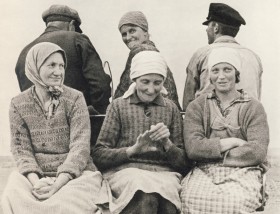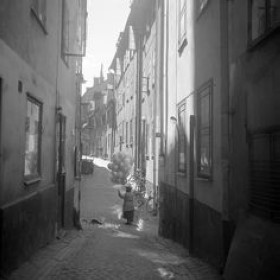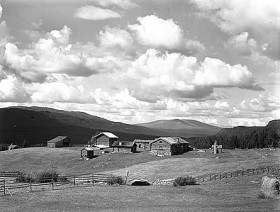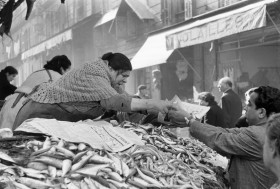It’s 9.45am June 13th 1997. The location is the old Kino Gudhjem on Bornholm, the island in the middle of the Baltic Sea. The first Baltic Sea Forum for Documentaries is to take off, there is a panel of commissioning editors waiting to listen to words from those pitching and to watch a trailer.
25 projects were lined-up, and a long day lay ahead of us. 15 minutes were given to each project according to the rules that had been set up years before at the Forum in Amsterdam. Those same rules that are still used at the many documentary fora all over the world.
The panel was strong. Makes me smile with nostalgia, when I think of experienced people like Björn Arvas from Swedish SVT, Flemming Grenz from Danish DR and Eila Werning from YLE in Finland. They have all, 20 editions later, retired now, but again and again this trio came back to support the filmmakers from the region. As did – in the first years of the Forum – Nick Fraser from BBC and Mette Hoffmann Meyer from TV2 Denmark. Not to forget Karolina Lidin from National Film Board of Denmark (Statens Filmcentral), who was already involved in the festival, that had been running on Bornholm since 1990, founded by TV2 Bornholm’s Bent Nørby Bonde, who then set up BMC, Baltic Media Centre.
Russian Avant-Garde
A key person in this Bornholmian film adventure – as it was for me and many others – was Sonja Vesterholt and as we moderators (John Marshall and I) knew that Sonja was a superb pitcher, she was the one selected to start the show that morning in Gudhjem. She did so together with Alexander Krivonos, director from St. Petersburg, the hometown of Sonja, with a project called Searching of the Russian Avant-garde Artists; it was also pitched in Amsterdam at IDFA. Russian Avant-Garde became a great film due to Krivonos cinematic skills with Sonja as the perfect producer. A classic on this theme.
There were two catalogues on the table. One included the projects developed at a week- long workshop preceding the pitching that took place on the last day of the festival. The other catalogue consisted of projects that most often came from filmmakers, who attended the festival with their films. This first edition featured the Lithuanian poetic school of documentaries, represented by the now well-known artists Audrius Stonys, Arunas Matelis and Valdas Navasaitis.
Guardian Angels
The Forum remained on Bornholm for its first four editions, produced by Latvians – Lelda Ozola, the first three, and Ilze Gailite Holmberg, number four. These two names, guardian angels of the Forum, will pop up several times in this text celebrating the 20 years of a Forum that has travelled to different locations with the aim of getting Eastern European documentaries and documentarians known and shown in the Western part of the world.
1998 and 1999 were years where the panels also included people like Iikka Vehkalahti from Finnish YLE, Diane Weyermann from Soros Documentary Fund and IDFA director and founder Ally Derks, who represented the Jan Vrijman Fund. They were all very positive to Latvian veteran Ivars Seleckis, when he presented his second film on the Riga Crossroad Street, which turned out as successful as expected – the surprise, however, was the overall (mainly from female editors around the table) support to the pitch of Latvian producer Guntis Trekteris and director Una Celma’s Egg Lady, a short documentary about a woman, who as her job breaks 20.000 eggs per day. Shot on 35mm, 26 mins., nothing really happens but the egg-breaking, a minimalistic masterpiece, a kind of film that would not stand a chance today, 20 years later.
Going South
With BMC as the locomotive and Bent Nørby Bonde and Simon Drewsen Holmberg as conductors something had to change, when the Danish state no longer wanted to support the festival = cultural activities to develop the Baltic countries. BMC (and the Danish state’s focus) had started to be on the Balkan region and it was thus natural to think that a collaboration could be established between the Baltic and the Balkan region. In 2000 filmmakers from the South came to the festival and the Forum and a co-production meeting between East and West was set up. The idea was a simple consequence of how films are financed – if you wish to access funding in another country than your own, you need to have an alliance with a co-producing company in that country. So experienced producers from the East met with their counterparts to share and see if chemistry worked.
In 2001 the festival and the Forum took place in beautiful Dubrovnik, under the name ”5th Baltic & SEE Forum for Documentaries”. As one of those who went to Dubrovnik for preparation of the festival and the Forum, it would be wrong to say that it was easy, very much – in retrospect – because of us Northerners ignoring Southern way of life. How could we make film screenings at 2pm, siesta time, in June in the South…. No one came! They were all on the beach!
Anyway, thanks to local collaborators and the logistical and technical skills of event producer Ilze Gailite Holmberg and Andreas Steinmann, a key person at the festival on Bornholm and now here, a Forum was performed that included the presentation of what became a masterpiece like Arunas Matelis Before the Flight to the Earth (when finished it won first prizes in both Leipzig and Amsterdam), Bulgarian Adela Peeva’s This is not My Song, Romanian Florin Lepan’s film on Tarzan aka Johnny Weissmuller. Furthermore the father of Croatian documentary, Nenad Puhovski pitched on this occasion as did Hungarian Diana Groó.
Back to the North
At the 6th edition it was back to the North. It was not possible to develop the festival and Forum in the South, but the link to the South was kept. Four of the 24 projects were invited from SEE, South East Europe, where the BMC kept on being active through workshops and consultancy in the audio-visual sector. But alas, NO MORE festival, when will it come back…
Back to the North, to Riga, with the involvement of the Latvian Producers Association and with Guntis Trekteris as producer of the 2001 and 2002 event at the Hotel Riga. That hosted an impressive panel of people from TV stations like arte, zdf, YLE, NDR, RTBF, ORF (wonderful Franz Grabner, RIP), DR, TV2. The Baltic broadcasters started to send representatives. Marje Jurtshenko from Estonian Television to mention the one, who has influenced the atmosphere of the discussions so often and still does.
Let me drop some titles from these two years: Romeo and Juliet by Viesturs Kairiss, Dreamland by Laila Pakalnina, Philosopher Escaped by Robert Vinovskis, My Husband Andrei Sakharov by Inara Kolmane, Seda, the Marsh Country by Kaspars Goba – all Latvian – and Countdown by Lithuanian Audrius Stonys.
It was also in Riga that we first welcomed a pitch by Ukrainian Svetlana Zinovyeva and one by the Belorussian master Yuri Khashchevatsky, a man not liked by Lukashenko! To express an understatement!
Hans Christian Andersen…
On the financial side, as of 2003, the Forum has been generously supported by the EU MEDIA programme with EDN (European Documentary Network) as the applicant partner until 2006 and the National Film Centre of Latvia as of 2007.
In 2004 the Forum landed in Tallinn to be produced by director and producer Riho Västrik, who is still a strong supporter of the Forum bringing his students from the Baltic Film and Media School to attend as observers. 2004 was the year when the Baltic countries entered the EU, became part of the family as many phrased it. Simon Drewsen Holmberg, managing director of the BMC, brought in Hans Christian Andersen in his preface of the Forum catalogue:
“As any other commercial market it is the intersection where interested sellers and buyers meet. It is hence very promising to see that today this market is not just a place where “Eastern” Producers meets “Western” buyers. It is also a place where “East” meets “East” and in the future we may also present “Western” projects for eager “Eastern” Com. eds. We may finally conclude that the Baltic Forum is becoming in even more ways a beautiful Swan. But then not too much I hope — because if you are into film-production — you have to thrive with starting off as an Ugly Duckling each time…. “.
Two Estonian directors – who now have a fine reputation internationally – pitched in the capital of their country. Jaak Kilmi was there with his “Art of Selling” and Marianna Kaat presented “The Last Phantoms“, what became her beautiful film on the Mariinsky Theatre in St. Petersburg.
The swan flew to Vilnius in 2005 to be caressed by producer Rasa Miskinyte and her staff, who set up a film screening programme parallel to the Forum, a tradition that has been continued since then. When in Vilnius I had to write this in the preface to the catalogue:
“…Allow me to think back to the key person in Lithuanian documentary, Henrikas Sableviciaus, who was a teacher, organiser, dramaturg and director himself. Henrikas attended all festivals on Bornholm, shared his enormous generosity with everyone. Always enthusiastic about the documentary genre. Henrikas died last year. Let us pay tribute to his memory!”.
What was visible at that year’s Forum was the increase of projects from Ukraine and Belarus – and about Belarus, remembering the fine work of Polish Miroslaw Dembinski, Belarusian Lesson.
The Forum Finds a Permanent Base
10 years old the Forum was looking for a permanent home and Riga welcomed it with a location on the top floor of Hotel Albert named after Einstein and near the streets, where Sergei Eisenstein grew up and where his architect father Michael Eisenstein built the famous houses. This is where we have been, year after year, with the warm professionalism of Zelda = Zanda Dudina and Lelda Ozola as the fundament and with a parallel excellent film programme, for years initiated by Ilze Gailite Holmberg, as director of the organizer, the National Film Centre of Latvia. These names keep on coming back: Ilze, Lelda…
And in 2006 the 10th Forum was supported by fine words by the Latvian Minister of Culture Helena Demakova: “…The greatest documentary film professionalism is hidden in the ability to indirectly reflect something of one’s own life through the life of others. Documentary film on very rare occasions asks the question: what is happening. Documentary film asks: how does it happen. And perhaps also – why does it happen that way. At the same time, it’s in the viewer’s competence to see where it’s leading. And the viewer is the third most important element in creating documentary film. Right after the doer and the observer…” Demakova, by the way, pitched in the role of a scriptwriter at the very first Forum in Svaneke 1997 as did Ilze Gailite Holmberg as a producer…
One more quote from Demakova, who was also Minister of Culture in 2007 and wrote this: “…The organisers of the Forum have added a film programme entitled Documentaries that Shook the World, among them a documentary on Alexander Litvinenko by his friend and film author Andrei Nekrasov, a documentary Kalinovsky Square (by Yuri Khashchevatsky) on fight of the political opposition in Belarus and documentaries on September 11, 2001…”
Catalogues and Decision Makers
The catalogue is now in four colour great design, two pages per pitched film project, overview of the film programme running parallel, seminars for pitching participants and local professionals, cv’s of panelists and tutors… it’s all there, professional and inviting, one of those catalogues that you keep on your shelf, not to be thrown away for 11 years created by the corporate designer of the Baltic Sea Forum – a Latvian Arnis Grinbergs.
At the 10th edition in 2006 the Georgians arrived… sure they did! One of the Georgians, Besarion Giorgobiani (Beso) with a project called “The Dancer”, shocked the decision makers by – yes, of course – dancing his pitch!
Note that I wrote “decision makers”. Because of one of the important changes in the panels this last decade: sales agents from companies like Autlook, Taskovski Films, Deckert Distribution, First Hand Films, Rise and Shine… have been invited to sit in as their role as go-betweens to the commissioning editors have grown enormously, at the same speed (no reason to hide that) as the financial importance of the commissioning editors have decreased. There is not that much money available at the public TV stations for creative documentaries as before, at the same time as new smaller markets have emerged, like the non-theatrical, like the VOD, like – not to be underestimated, the festivals. Festival money is not money that you get up-front for your production budget but with the right distributor and the right good-for-festivals film, you can easily get a good income – multiply as an example 50 festival fees with €300, some pay €500.
Films that Will Travel
Back to the impressive list of films that have passed the Baltic Sea Docs during the 10 editions at Albert Hotel, on the top floor with two days of pitching of 24 film projects, preceded by a workshop of three days, where the projects have been analysed and commented by so-called experts and colleagues via intense discussion from morning till night. It is not to be underestimated, what these meetings have created in terms of collaboration across the borders. Developing the projects in a few days often with the help of TV commissioning editors, who love to take part in a creative process.
The list – Man-Horse by Lithuanian Audrius Mickevius with the most crazy trailer ever. Antra Cilinska’s Is it Easy to be – After 20 Years, a film historical follow-up to Juris Podnieks perestroika film that Cilinska edited. Salomé Jashi’s Bakhmaro, Pakalnina’s Snow-Crazy, the amazing compilation film 15 Young by Young by tornado producer Ilona Bicevska, Russian Alina Rudnitskaya’s Blood of the stranger, Mindaugas Survila’s Field of Magic, Giedre Zickyte’s film about Luckus, the Russian Tatyana Soboleva’s film about the Siberian floating hospital, Davis Simanis film on the national library… I could go on… political ”hot” film as The Term with Estonian Max Tuula as producer and Beyond Fear by Herz Frank, his last film that he did not finish. Maria Kravchenko and producer Guntis Trekteris did so. In 2015 courageous Russian director Askold Kurov pitched ”Release Oleg Sentsov”, still not finished.
And the Next Project…
Have to close this celebration text on the Baltic Sea Forum during 20 years. Thanks for letting me be part of the furniture. Thanks for letting me into a world of documentaries that I have become totally addicted to: documentaries from the East of Europe. From Tallinn and St. Petersburg to Belgrade and Kosova.
When Mikael Opstrup from EDN and I again-again, as the old boys, moderators of this event, welcome a panel of decision makers and first of all a group of filmmakers from many countries to present their film project, we do so proudly knowing that it has meant something to have this yearly 20 year old gathering for people, who work with a film genre, that has definitely grown in importance during these 20 years. We all know that there is an audience out there on all the platforms available. An audience that deserves the best that you can offer, you creative artists…
… and the next project comes from… you have 15 minutes for your pitch, half of the time for your words and your visuals, half of the time for reactions, questions and answers. Action!
IMPORTANT: YOU CAN HAVE THE 40 PAGES BRILLIANTLY ILLUSTRATED PUBLICATION SENT TO YOU FOR FREE BY CONTACTING balticforum@nkc.gov.lv
Photo: Ten Minutes Older, Herz Frank, Juris Podnieks (Camera), 1978.
Tue Steen Müller







